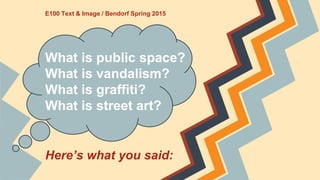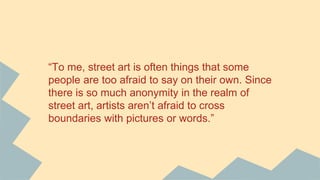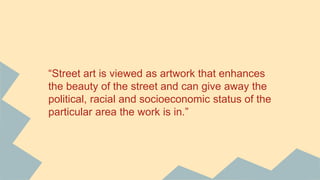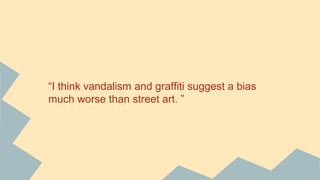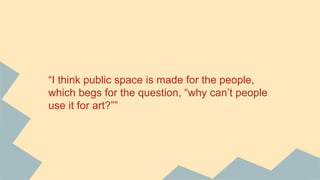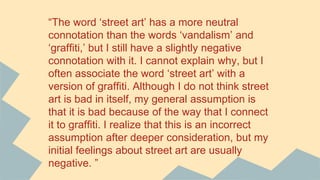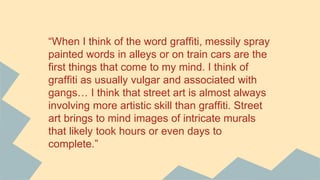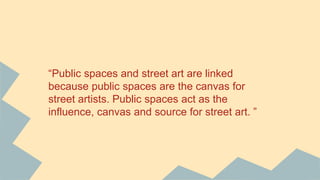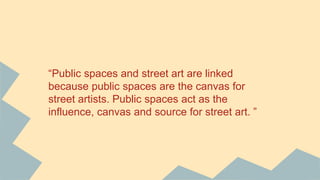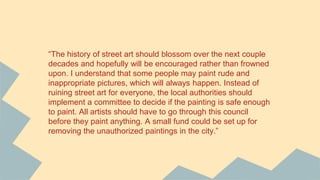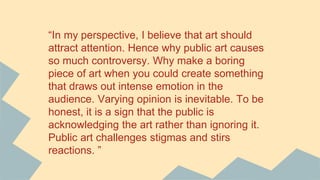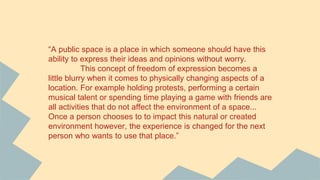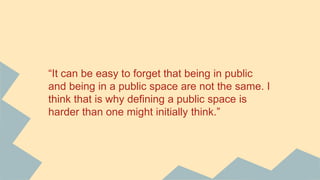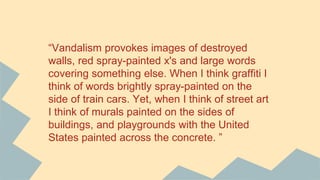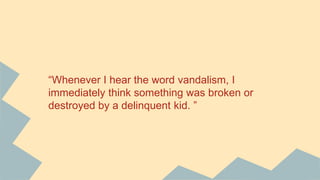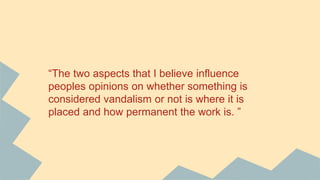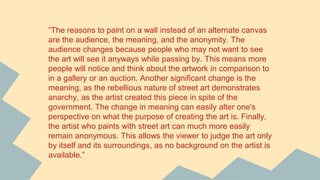Public space and public art: e100 lesson plan
- 1. E100 Text & Image / Bendorf Spring 2015 What is public space? What is vandalism? What is graffiti? What is street art? Hereâs what you said:
- 2. âTo me, street art is often things that some people are too afraid to say on their own. Since there is so much anonymity in the realm of street art, artists arenât afraid to cross boundaries with pictures or words.â
- 3. âI see graffiti as the bridge between the other two terms since it can be vandalism and it can be artâ
- 4. âStreet art has many benefits, but it can lead to problems when it is unwanted. With an appropriate intent, a community can always benefit from street art.â
- 5. âPublic space is a term that can be defined many different ways. Is it for everyone? Can I alter how it appears? Why are there so many restrictions on it? I believe that the true definition should be space that can be enjoyed by everyone. It can be a place where people can voice their opinions and not get punished for it.â
- 6. âStreet art is viewed as artwork that enhances the beauty of the street and can give away the political, racial and socioeconomic status of the particular area the work is in.â
- 7. âI think vandalism and graffiti suggest a bias much worse than street art. â
- 8. âThere is a fine line between the words vandalism and street art. It is left to the viewer to decide; this sometimes shifts the meaning to the opposite of its original purpose. This fine line is the problem the artists face when they paint or draw in public space. They may have meant to improve the medium but the community may not think it belongs or is appropriate. All of these pieces produce a meaning and have a context; sometimes they just are not in the right location to succeed. â
- 9. âI think public space is made for the people, which begs for the question, âwhy canât people use it for art?ââ
- 10. âThe word âstreet artâ has a more neutral connotation than the words âvandalismâ and âgraffiti,â but I still have a slightly negative connotation with it. I cannot explain why, but I often associate the word âstreet artâ with a version of graffiti. Although I do not think street art is bad in itself, my general assumption is that it is bad because of the way that I connect it to graffiti. I realize that this is an incorrect assumption after deeper consideration, but my initial feelings about street art are usually negative. â
- 11. âWhen I think of the word graffiti, messily spray painted words in alleys or on train cars are the first things that come to my mind. I think of graffiti as usually vulgar and associated with gangsâĶ I think that street art is almost always involving more artistic skill than graffiti. Street art brings to mind images of intricate murals that likely took hours or even days to complete.â
- 12. âI personally love street art, because I think that the expression of ideas is more meaningful when it is not wanted. Even murals and large billboards, are often more enchanting for me than a piece of art in a museum. I enjoy the spontaneity of street art because you never know where you will find it, and how long it will last. â
- 13. âPublic spaces and street art are linked because public spaces are the canvas for street artists. Public spaces act as the influence, canvas and source for street art. â
- 14. âPublic spaces and street art are linked because public spaces are the canvas for street artists. Public spaces act as the influence, canvas and source for street art. â
- 15. âGrowing up, I always thought that graffiti was a bad thing because it involved destruction of someone elseâs property. Even though this may be the intention of some graffiti artists, many artists just want to let out their creativity.â
- 16. âThe history of street art should blossom over the next couple decades and hopefully will be encouraged rather than frowned upon. I understand that some people may paint rude and inappropriate pictures, which will always happen. Instead of ruining street art for everyone, the local authorities should implement a committee to decide if the painting is safe enough to paint. All artists should have to go through this council before they paint anything. A small fund could be set up for removing the unauthorized paintings in the city.â
- 17. âIn my perspective, I believe that art should attract attention. Hence why public art causes so much controversy. Why make a boring piece of art when you could create something that draws out intense emotion in the audience. Varying opinion is inevitable. To be honest, it is a sign that the public is acknowledging the art rather than ignoring it. Public art challenges stigmas and stirs reactions. â
- 18. âA public space is a place in which someone should have this ability to express their ideas and opinions without worry. This concept of freedom of expression becomes a little blurry when it comes to physically changing aspects of a location. For example holding protests, performing a certain musical talent or spending time playing a game with friends are all activities that do not affect the environment of a space... Once a person chooses to to impact this natural or created environment however, the experience is changed for the next person who wants to use that place.â
- 19. âWith regards to the audience of each of these acts, I believe they differ greatly. Vandalism is mainly meant for the owner of whatever property was destroyed, and could be used in a threatening manner to get back at a person. The audience of vandalism is very limited and unless it is a huge act of vandalism, only the owner and possibly the police will see it. Graffiti has the chance to appear to a larger audience because it tends to appear in more public places; personally I have seen a decent amount of graffiti on train cars as they pass by or under bridges as I drive past... The intent of street art is similar to graffiti in that the artists want to create a reaction within the general public who sees the art; for example in Barcelona, when street art is created, thousands of people see their creation in one day.â
- 20. âIt can be easy to forget that being in public and being in a public space are not the same. I think that is why defining a public space is harder than one might initially think.â
- 21. âVandalism provokes images of destroyed walls, red spray-painted x's and large words covering something else. When I think graffiti I think of words brightly spray-painted on the side of train cars. Yet, when I think of street art I think of murals painted on the sides of buildings, and playgrounds with the United States painted across the concrete. â
- 22. âWhen I was little I was always told that vandalism and graffiti were bad. Those were things that gangs did, and they were illegal. Thinking about it now, I find this very interesting, because a lot of times what one person considers vandalism another considers a work of art.â
- 23. âWhenever I hear the word vandalism, I immediately think something was broken or destroyed by a delinquent kid. â
- 24. âMore and more street art nowadays is located in private galleries. Years ago, artists could easily display their art in public spaces, however laws changed and so did the way in which some perceived public space art. â
- 25. âThe two aspects that I believe influence peoples opinions on whether something is considered vandalism or not is where it is placed and how permanent the work is. â
- 26. âThe reasons to paint on a wall instead of an alternate canvas are the audience, the meaning, and the anonymity. The audience changes because people who may not want to see the art will see it anyways while passing by. This means more people will notice and think about the artwork in comparison to in a gallery or an auction. Another significant change is the meaning, as the rebellious nature of street art demonstrates anarchy, as the artist created this piece in spite of the government. The change in meaning can easily alter one's perspective on what the purpose of creating the art is. Finally, the artist who paints with street art can much more easily remain anonymous. This allows the viewer to judge the art only by itself and its surroundings, as no background on the artist is available.â
- 27. âThe actions of the artist may promote creativity and diversity, but also destroy government and unity. The main problem existing in street art is the various legal ways artists can express themselves without the need to destroy property.â
- 28. âStreet art (when not permitted) causes too much damage and creates an insecure feeling causing most people to feel uninvited. Public space is reserved for everyone, and nobody should feel left out due to safety concerns. Artwork can be placed in public space if it is universally wanted. Otherwise, the rebellious nature of this style art causes too much insecurity for it to be justifiable. â
- 29. Debating the Texas tree & billboard bill http://dfw.cbslocal.com/2015/ 03/23/bill-would-allow- businesses-to-cut-down- trees-around-billboards/
- 30. Format: Things to consider: 1. Opening statements (include 3 arguments) 2. Rebuttals 3. Closing arguments (include a quote from Ways of Seeing pp. 129- 154 that supports your teamâs position) â Audience â Purpose â Location â Public space (What it is, what itâs for) â Images (What they are, what theyâre for)

